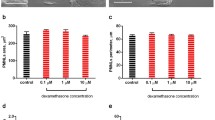Abstract
In an experimental system in which phagocytosis or adherence of cells to surfaces were excluded as variables, we have investigated the possibility that corticosteroids may inhibit release of lysosomal constituents from viable human polymorphonuclear leukocytes into the extracellular environment. Release ofΒ-glucuronidase and lysozyme from cytochalasin B-treated cells exposed to serum-treated zymosan, heat-aggregated human IgG, and the complement component C5a was significantly reduced by pretreatment with hydrocortisone sodium succinate and methylprednisolone sodium succinate (5×10−4 M). Both steroids also reduced superoxide production by these cells. These in vitro studies provide evidence that corticosteroids influence membrane-dependent responses of intact, viable polymorphonuclear leukocytes to immune reactants. Inhibition of these responses (lysosomal enzyme release, superoxide production) may explain, in part, both the antiinflammatory actions of steroids and their deleterious effects on host defenses.
Similar content being viewed by others
References
Weissmann, G. 1964. Labilization and stabilization of lysosomes.Fed. Proc. Fed. Am. Soc. Exp. Biol. 23:1038.
Weissmann, G., andL. Thomas. 1964. Effects of corticosteroids upon connective tissue and lysosomes.Recent Prog. Horm. Res. 20:215.
Goldstein, I.M. 1974. Lysosomal hydrolases and inflammatory materials.In Mediators of Inflammation. G. Weissmann, editor. Plenum Publishing Corporation, New York. Chap. 2, pp. 51–84.
Klebanoff, S.J. 1975. Antimicrobial systems of the polymorphonuclear leukocyte.In The Phagocytic Cell in Host Resistance. J. A. Bellanti and D.H. Dayton, editors. Raven Press, New York. pp. 45–56.
Persellin, R.H., andL.C. Ku. 1974. Effects of steroid hormones on human polymorphonuclear leukocyte lysosomes.J. Clin. Invest. 54:919.
Wright, D.G., andS.E. Malawista. 1973. Mobilization and extracellular release of granular enzymes from human leukocytes during phagocytosis: inhibition by colchicine and cortisol but not by salicylate.Arthritis Rheum. 16: 749.
Hawkins, D. 1974. Neutrophilic leukocytes in immunologie reactionsin vitro. III. Pharmacologie modulation of lysosomal constituent release.Clin. Immunol. Immunopathol. 2:141.
Ignarro, L.J. 1974. Release of neutral protease andΒ-glucuronidase from human neutrophils in the presence of cartilage treated with various immunologie reactants.J. Immunol. 113:298.
Goldstein, I.M., D. Roos, G. Weissmann, andH.B. Kaplan, 1975. Complement and immunoglobulins stimulate superoxide production by human leukocytes independently of phagocytosis.J. Clin. Invest. 56:1155.
Goldstein, I.M., M. Brai, A.G. Osler, andG. Weissmann. 1973. Lysosomal enzyme release from human leukocytes: mediation by the alternate pathway of complement activation.J. Immunol. 111:33.
Goldstein, I.M., S. Hoffstein, J. Gallin, andG. Weissmann. 1973. Mechanisms of lysosomal enzyme release from human leukocytes: microtubule assembly and membrane fusion induced by a component of complement.Proc. Nat. Acad. Sci. U.S.A. 70:2916.
Lowry, O.H., N.J. Rosebrough, A.L. Farr, andR.J. Randall. 1951. Protein measurement with the Folin phenol reagent.J. Biol. Chem. 193:265.
Baumstark, J.S., R.J. Laffin, andW.A. Bardawil. 1964. A preparative method for the separation of 7s gamma globulin from human serum.Arch. Biochem. Biophys. 108:514.
Henson, P.M., H.B. Johnson, andH.L. Spiegelberg. 1972. The release of granule enzymes from human neutrophils stimulated by aggregated immunoglobulins of different classes and subclasses.J. Immunol. 109:1182.
Brittinger, G., R. Hirschhorn, S.D. Douglas, andG. Weissmann. 1968. Studies on lysosomes. XI. Characterization of a hydrolase-rich fraction from human lymphocytes.J. Cell Biol. 37:394.
Worthington Enzyme Manual. 1972. Worthington Biochemical Corporation. Freehold, New Jersey, pp. 100, 101.
Wacker, W.E.C., D.D. Ulmer, andB.L. Vallee. 1956. Metalloenzymes and myocardial infarction. II. Malic and lactic dehydrogenase activities and zinc concentration in serum.N. Engl. J. Med. 255:449.
Van Gelder, B.F., andB.C. Slater. 1962. The extinction coefficient of cytochromec.Biochim. Biophys. Acta 58:593.
McCord, J.M., and I.Fridovich. Superoxide dismutase. An enzymatic function for erythrocuprein (hemocupreine).J. Biol. Chem. 244:6049.
Stossel, T.P., R.J. Mason, J. Hartwig, andM. Vaughan. 1972. Quantitative studies of phagocytosis by polymorphonuclear leukocytes: use of emulsions to measure the initial rate of phagocytosis.J. Clin. Invest. 51:615.
Davis, A.L, R. Estensen, andP.G. Quie. 1971. Cytochalasin B III. Inhibition of human polymorphonuclear leukocyte phagocytosis.Proc. Soc. Exp. Biol. Med. 137:161.
Zurier, R.B., S. Hoffstein, andG. Weissmann. 1973. Cytochalasin B: effect on lysosomal enzyme release from human leucocytes.Proc. Nat. Acad. Sci. U.S.A. 70:844.
Weissmann, G. 1973. Effects of corticosteroids on the stability and fusion of biomembranes.In Asthma Physiology, Immunopharmacology, and Treatment. K.F. Austen and L.M. Lichtenstein, editors. Academic Press Incorporated, New York. pp. 221–233.
Schieren, H., M. Seligman, P. Coleman, andG. Weissmann. 1976. Interaction of immunoglobulins with liposomes: an ESR study.Fed. Proc. Fed. Am. Soc. Exp. Biol. 35:274.
Bangham, A.D., M.M. Standish, andG. Weissmann. 1965. The action of steroids and streptolysin S on the permeability of phospholipid structures to cations.J. Mol. Biol. 13:253.
Logsdon, P.J., E. Middleton, Jr, andR.G. Coffey. 1972. Stimulation of leukocyte adenyl cyclase by hydrocortisone and isoproterenol in asthmatic and nonasthmatic subjects.J. Allergy Clin. Immunol. 50:45.
Yielding, K.L., andG.M. Tomkins. 1959. Inhibition of the enzymic oxidation of DPNH by steroid hormones.Proc. Nat. Acad. Sci. U.S.A. 45:1730.
Mandell, G.L., W. Rubin, andE.W. Hook. 1970. The effect of an NADH oxidase inhibitor (hydrocortisone) on polymorphonuclear leukocyte bactericidal activity.J. Clin. Invest. 49:1381.
Babior, B.M., J.T. Curnutte, andR.S. Kipnes. 1975. Pyridine nucleotide-dependent superoxide production by a cell-free system from human granulocytes.J. Clin. Invest. 56:1035.
Chretien, J.H., andV.F. Garagusi. 1972. Corticosteroid effect on phagocytosis and NBT reduction by human polymorphonuclear neutrophils.Res. J. Reticuloendothel. Soc. 11:358.
Cooper, M.R., L.R. DeChatelet, andC.E. McCall. 1972. Thein vitro effect of steroids on polymorphonuclear leukocyte metabolism.Proc. Soc. Exp. Biol. Med. 141:986.
DeChatelet, L.R., P.S. Shirley, P.R. Goodson, andC.E.M. McCall. 1975. Bactericidal activity of superoxide anion and of hydrogen peroxide: investigations employing dialuric acid, a superoxide-generating drug.Antimicrob. Agents Chemother. 8:146.
Author information
Authors and Affiliations
Additional information
This research was supported by grants from the National Institutes of Health (AM-18531, AM-11949, and HL-15140) and by the Whitehall Foundation.
Career Scientist of the Irma T. Hirschl Trust.
Rights and permissions
About this article
Cite this article
Goldstein, I.M., Roos, D., Weissmann, G. et al. Influence of corticosteroids on human polymorphonuclear leukocyte function in vitro. Inflammation 1, 305–315 (1976). https://doi.org/10.1007/BF00917870
Issue Date:
DOI: https://doi.org/10.1007/BF00917870



